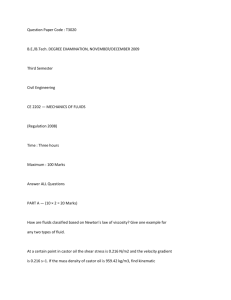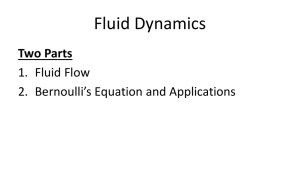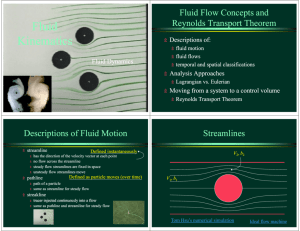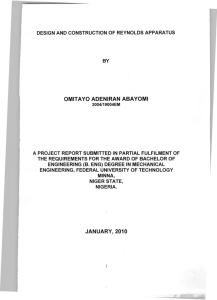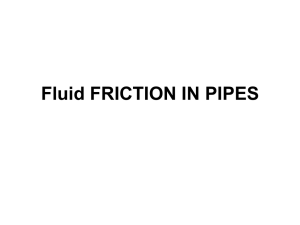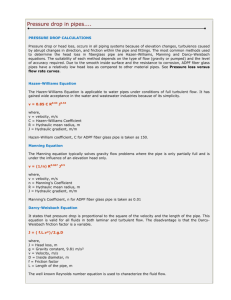Topics to be covered
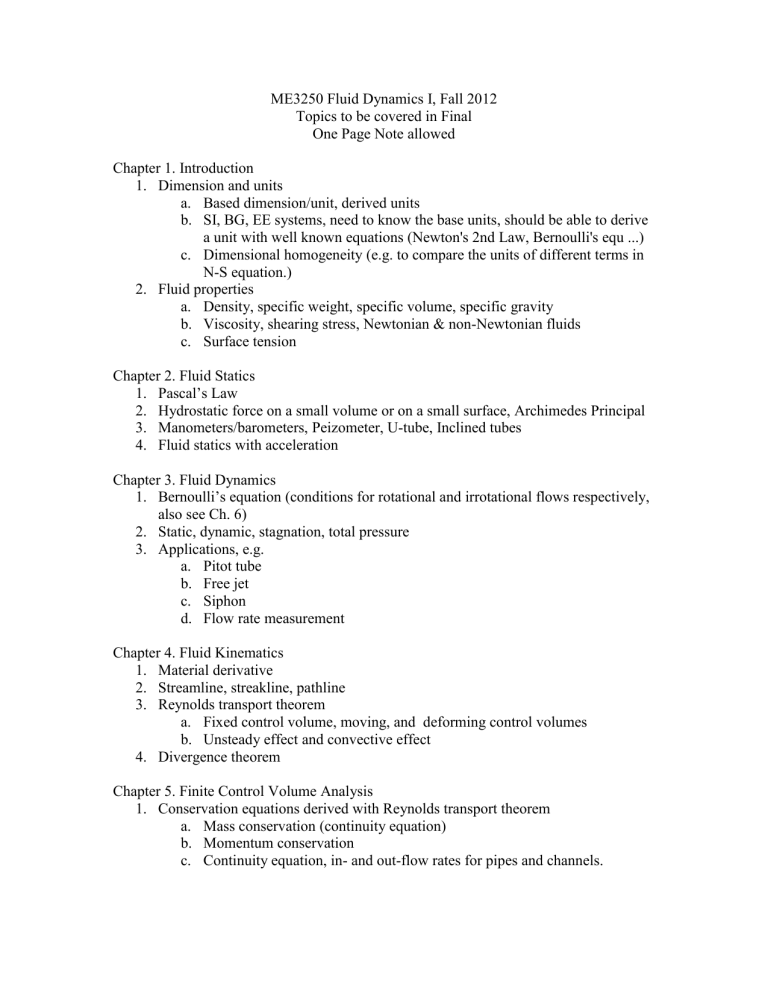
ME3250 Fluid Dynamics I, Fall 2012
Topics to be covered in Final
One Page Note allowed
Chapter 1. Introduction
1.
Dimension and units a.
Based dimension/unit, derived units b.
SI, BG, EE systems, need to know the base units, should be able to derive a unit with well known equations (Newton's 2nd Law, Bernoulli's equ ...) c.
Dimensional homogeneity (e.g. to compare the units of different terms in
N-S equation.)
2.
Fluid properties a.
Density, specific weight, specific volume, specific gravity b.
Viscosity, shearing stress, Newtonian & non-Newtonian fluids c.
Surface tension
Chapter 2. Fluid Statics
1.
Pascal’s Law
2.
Hydrostatic force on a small volume or on a small surface, Archimedes Principal
3.
Manometers/barometers, Peizometer, U-tube, Inclined tubes
4.
Fluid statics with acceleration
Chapter 3. Fluid Dynamics
1.
Bernoulli’s equation (conditions for rotational and irrotational flows respectively, also see Ch. 6)
2.
Static, dynamic, stagnation, total pressure
3.
Applications, e.g. a.
Pitot tube b.
Free jet c.
Siphon d.
Flow rate measurement
Chapter 4. Fluid Kinematics
1.
Material derivative
2.
Streamline, streakline, pathline
3.
Reynolds transport theorem a.
Fixed control volume, moving, and deforming control volumes b.
Unsteady effect and convective effect
4.
Divergence theorem
Chapter 5. Finite Control Volume Analysis
1.
Conservation equations derived with Reynolds transport theorem a.
Mass conservation (continuity equation) b.
Momentum conservation c.
Continuity equation, in- and out-flow rates for pipes and channels.
d.
Continuity together with momentum equations for computing forces acted on a control volume
Chapter 6. Differential Equations
1.
Be familiar with the differential equations for mass and momentum conservation and understand the physical meaning of each term.
2.
Divergence theorem (to convert surface integral to volumetric integral)
3.
Be familiar with the terms on RHS of momentum (Navier-Stokes) equations: hydrostatic force (volumetric form), gravity, and viscous force
4.
Fluid element kinematics: quantification of fluid element dilatation, rotation, and deformation
5.
Computation of viscous force on a given surface with given velocity field
6.
Navier-Stokes equations for incompressible & Newtonian flow
7.
Simplification of N-S equation for, e.g., steady state, fully developed, 1-D or 2-D flows (5 examples of simple viscous flows). For example: Couette flow, channel or pipe flows driven by pressure gradient and/or gravity. Should be able to simplify the N-S equation to simple ODEs using appropriate assumptions and use boundary conditions to determine the constants generated from integration.
8.
Inviscid flow, irrotational flow, Potential flow
Potential/stream functions for typical potential flows
Superposition of potential flows
Compute potential/stream function from velocity and vice versa.
Lift, drag, pressure distribution
Bernoulli’s equation for irrotational flows
Chapter 7. Dimensional Analysis
1.
Dimensionless number. Frequently used dimensionless numbers in Fluid mechanics and their meanings
2.
Buckingham Pi theorem, systematic procedure to obtain dimensionless numbers
3.
Modeling
Chapter 8. Pipe Flows
1.
Fully developed laminar channel flows and pipe flows, need to know what equation to start from and how to simplify it to a simple ODE. Use appropriate boundary conditions to solve the constants from integration
2.
Velocity profile for fully developed pipe flows, (horizontal and inclined pipes)
3.
Relations of max/average velocity, pressure drop, gravity, pipe length, and pipe diameter.
4.
Computation of flow rate and pump power driving a pipe flow.
5.
Comparison of velocity profiles for laminar flow and turbulent pipe flows
6.
Laminar to turbulent flow transition, Reynolds number effect, turbulence viscosity, turbulence modeling. (basic concepts only)
Chapter 9: Flow over Immersed Bodies (basic concepts only)
1.
Structure of boundary layers: thickness, velocity profile
2.
Effect of Reynolds number on boundary layers.
3.
Lift and drag (coefficient)

